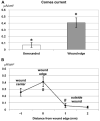Modulating endogenous electric currents in human corneal wounds--a novel approach of bioelectric stimulation without electrodes
- PMID: 21099404
- PMCID: PMC3061552
- DOI: 10.1097/ICO.0b013e3181f7f2de
Modulating endogenous electric currents in human corneal wounds--a novel approach of bioelectric stimulation without electrodes
Abstract
Purpose: To measure electric current in human corneal wounds and test the feasibility of pharmacologically enhancing the current to promote corneal wound healing.
Methods: Using a noninvasive vibrating probe, corneal electric current was measured before and after wounding of the epithelium of donated postmortem human corneas. The effects of drug aminophylline and chloride-free solution on wound current were also tested.
Results: Unwounded cornea had small outward currents (0.07 μA/cm²). Wounding increased the current more than 5 fold (0.41 μA/cm²). Monitoring the wound current over time showed that it seemed to be actively regulated and maintained above normal unwounded levels for at least 6 hours. The time course was similar to that previously measured in rat cornea. Drug treatment or chloride-free solution more than doubled the size of wound currents.
Conclusions: Electric current at human corneal wounds can be significantly increased with aminophylline or chloride-free solution. Because corneal wound current directly correlates with wound healing rate, our results suggest a role for chloride-free and/or aminophylline eyedrops to enhance healing of damaged cornea in patients with reduced wound healing such as the elderly or diabetic patient. This novel approach offers bioelectric stimulation without electrodes and can be readily tested in patients.
Figures




Similar articles
-
Ionic components of electric current at rat corneal wounds.PLoS One. 2011 Feb 25;6(2):e17411. doi: 10.1371/journal.pone.0017411. PLoS One. 2011. PMID: 21364900 Free PMC article.
-
Wound healing in rat cornea: the role of electric currents.FASEB J. 2005 Mar;19(3):379-86. doi: 10.1096/fj.04-2325com. FASEB J. 2005. PMID: 15746181 Free PMC article.
-
Airway epithelial wounds in rhesus monkey generate ionic currents that guide cell migration to promote healing.J Appl Physiol (1985). 2011 Oct;111(4):1031-41. doi: 10.1152/japplphysiol.00915.2010. Epub 2011 Jun 30. J Appl Physiol (1985). 2011. PMID: 21719726 Free PMC article.
-
Role of aquaporins in corneal healing post chemical injury.Exp Eye Res. 2023 Mar;228:109390. doi: 10.1016/j.exer.2023.109390. Epub 2023 Jan 22. Exp Eye Res. 2023. PMID: 36696947 Free PMC article. Review.
-
Wounding the cornea to learn how it heals.Exp Eye Res. 2014 Apr;121:178-93. doi: 10.1016/j.exer.2014.02.007. Epub 2014 Mar 4. Exp Eye Res. 2014. PMID: 24607489 Free PMC article. Review.
Cited by
-
Endogenous Bioelectrics in Development, Cancer, and Regeneration: Drugs and Bioelectronic Devices as Electroceuticals for Regenerative Medicine.iScience. 2019 Dec 20;22:519-533. doi: 10.1016/j.isci.2019.11.023. Epub 2019 Nov 25. iScience. 2019. PMID: 31837520 Free PMC article. Review.
-
Inducing Vertebrate Limb Regeneration: A Review of Past Advances and Future Outlook.Cold Spring Harb Perspect Biol. 2022 May 17;14(4):a040782. doi: 10.1101/cshperspect.a040782. Cold Spring Harb Perspect Biol. 2022. PMID: 34400551 Free PMC article. Review.
-
Ionic components of electric current at rat corneal wounds.PLoS One. 2011 Feb 25;6(2):e17411. doi: 10.1371/journal.pone.0017411. PLoS One. 2011. PMID: 21364900 Free PMC article.
-
Specific ion fluxes generate cornea wound electric currents.Commun Integr Biol. 2011 Jul;4(4):462-5. doi: 10.4161/cib.15545. Epub 2011 Jul 1. Commun Integr Biol. 2011. PMID: 21966572 Free PMC article.
-
Bioelectric Signaling: Role of Bioelectricity in Directional Cell Migration in Wound Healing.Cold Spring Harb Perspect Biol. 2022 Oct 3;14(10):a041236. doi: 10.1101/cshperspect.a041236. Cold Spring Harb Perspect Biol. 2022. PMID: 36041786 Free PMC article. Review.
References
-
- Bjarnsholt T, Kirketerp-Moller K, Jensen PO, et al. Why chronic wounds will not heal: a novel hypothesis. Wound Repair Regen. 2008;16:2–10. - PubMed
-
- Broughton G, Janis JE, Attinger CE. Wound healing: an overview. Plast Reconstr Surg. 2006;117:1e-S–32e-S. - PubMed
-
- Dinh TL, Veves A. Treatment of diabetic ulcers. Dermatol Ther. 2006;19:348–355. - PubMed
-
- Gurtner GC, Werner S, Barrandon Y, et al. Wound repair and regeneration. Nature. 2008;453:314–321. - PubMed
-
- McCaig CD, Rajnicek AM, Song B, et al. Controlling cell behavior electrically: current views and future potential. Physiol Rev. 2005;85:943–978. - PubMed
Publication types
MeSH terms
Substances
Grants and funding
LinkOut - more resources
Full Text Sources
Medical

